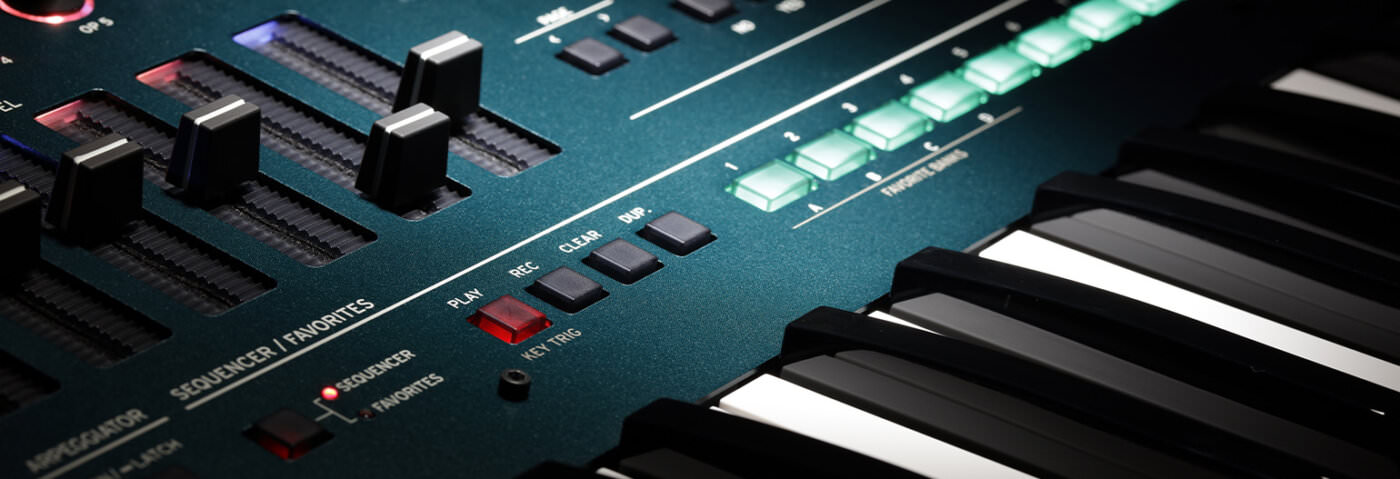Korg’s latest synth promises ‘altered’ FM synthesis. But is it more than just an overblown Volca FM?
When the prototype of the opsix appeared at NAMM 2020 it sparked a landslide of online speculation. Was this new FM instrument just a Yamaha DX7 clone with added sliders? It certainly looked like that, right down to the algorithm diagrams and an apparently brown finish. But, if it was, was it just a big Volca FM? Needless to say, both admirers and detractors of FM synthesis were eager for the official release.
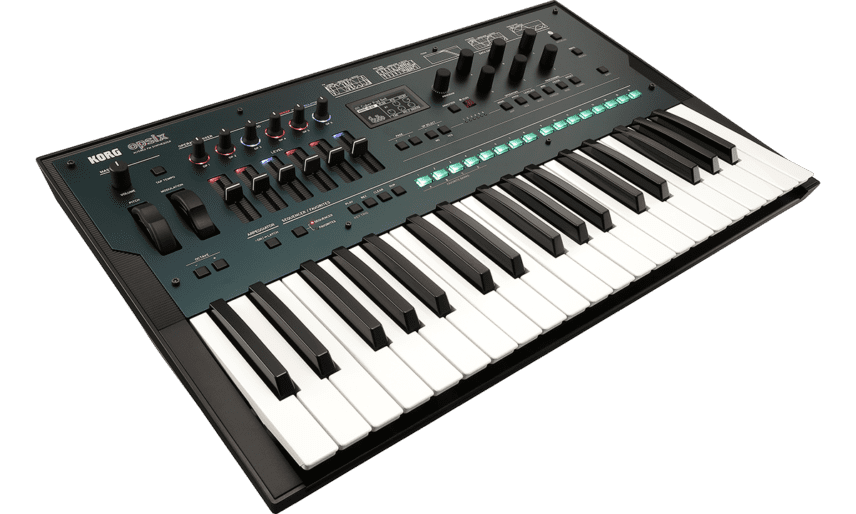
Fast-forward to the end of 2020 and the opsix is here but rather than being the five-octave beast that we expected it has been shrunken to fit the same compact body as the Wavestate. Our immediate thought when we took it from the box is that it’s a shame that it’s not battery powered. Here is a full-size instrument so light and robust that it would be perfect for carrying around for use on the fly. Although on power-up the facia looks like a seaside amusement arcade, which might make one a bit self-conscious composing on a busy commute.
What Is FM Synthesis?
What is FM? In basic terms, FM works by modulating a sine wave with other sine waves, using what are called operators, essentially a grouping of an oscillator, envelope, and amplifier that all interact with each other. The key to FM is that these operators can be chained together so that the output of one operator (the modulator) becomes the input of another (the carrier), a method that creates complex timbres very easily. Most FM synthesizers have at least four available operators but traditionally, as defined by the Yamaha DX series, there are six. These can be arranged in different orders, which are called algorithms.
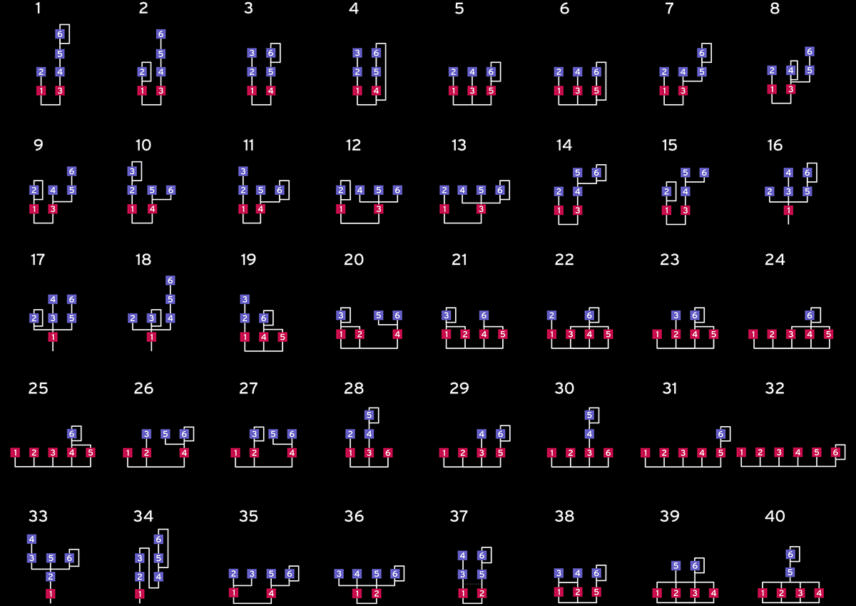
Altered FM
Korg call the opsix’s developments on the original FM formula Altered FM. In their words, it, “represents a new and expansive re-imagination of classic digital synthesis”. This sounds like marketing fluff but the fact is that Korg have added a huge amount of functionality to the traditional six-operator sound structure. So much, in fact, that despite being well labelled and a large OLED screen visualising menus and parameter adjustments in very understandable (albeit dated-looking) pixel matrix graphics, it was difficult to understand what was doing which to where. Whilst many synths allow anyone with a bit of basic knowledge to get up and running straight away, after some initial random tweaking we found ourselves reaching for the instruction manual.
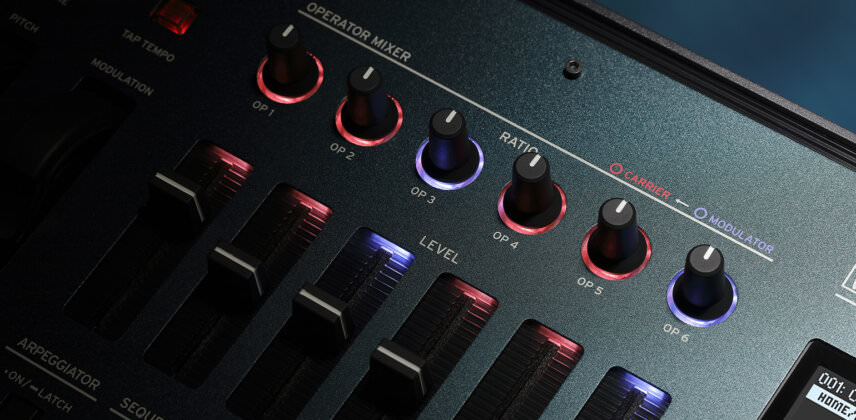
The opsix is 32-note polyphonic and ships with 250 preset voices and the same number of user blanks. Those who prefer to select a readymade sound, perhaps making some minor adjustments, are catered for very well – just turn the program select knob and scroll through the showcase of FM’s timbre capabilities. All the classic voices are present: pianos of all types, strings, percussion, swirling synth pads, et al. FM is perfect for synthesizing sounds with complex harmonics and dynamics, which is why the DX7 became famous for patches such as bells, pianos or swirling, cinematic synth pads – those same sounds that are now back on the radio and present and accounted for here.
Connectivity
As would be expected, the synth has the usual set of connectivity: 6.3mm stereo headphone jack, left/right balanced output jacks and damper jack, a USB B port for connection to laptops or devices and five-pin MIDI in/outs for connecting to other hardware. If so desired, SysEx files with FM parameter data can be uploaded via MIDI from a computer running SysEx Librarian or any of the various FM synth VSTs. As a general test, we installed the original DX7 master sounds using the freeware emulation, Dexed. In seconds they were copied to the empty presets.
Overwhelming Capabilities
For the more sound-design inclined, the capabilities of Altered FM are, honestly, somewhat overwhelming. Thankfully Korg have made it very easy to start your own ideas, at least – just press the handy Initialize button top right on the control panel and the current patch defaults to a pure sine wave. From then on in we found that the best way to approach the opsix is by dividing its many functions into three pillars. Pillar one handles the FM fundamentals. The 32 industry-standard algorithms are present and correct, plus eight developed by Korg, and an option to create your own. These are all accessed by the convenient Home/Algo button in the middle of the control panel.
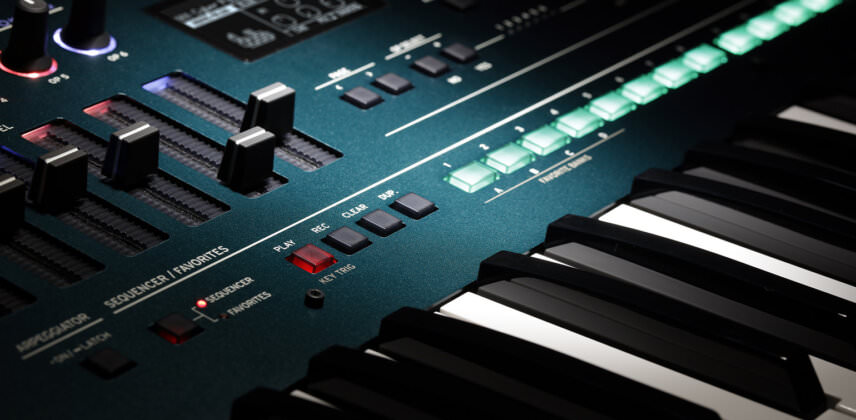
Six sliders and rotary encoders on the left side of the control panel then allow for easy editing of the pitch and volume for carrier operators, and the brightness or strength of harmonic for the modulator operators. To return to the opsix light show very quickly, a savvy feature is the use of two-coloured LEDs on the mixer, which clearly indicate the changing relationships between operators per each algorithm.
Beyond Pure FM
Moving to pillar two. Beyond pure FM there are four other operator modes – ring modulation, filter, filter FM, and wavefolder. These allow for sounds of even more complex harmonics than FM singularly provides as these can all be combined and, on top of that, a library of 20 waveforms offers choices beyond the default sine. A set of modulation possibilities are also applicable separate from those within the operators: three EGs (envelopes), three LFOs, and 12 virtual patches make a wide variety of routing possible. The opsix also allows for subtractive synthesis thinking with a range of eleven fully adjustable filters, including the lowpass/highpass from the MS-20, the soft lowpass from the Polysix; and two- or four-pole lowpass, highpass, bandpass and band reject filters with resonance.
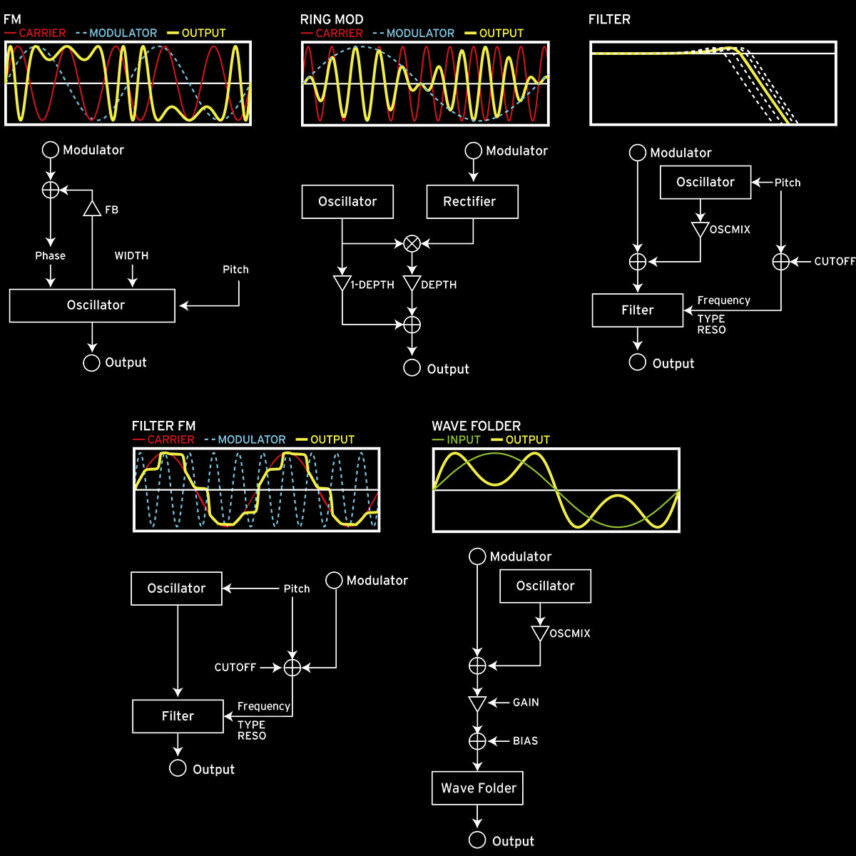
High-Definition Effects
Pillar three is devoted to processing. The opsix boasts 30 high-definition effects, again all fully adjustable, from the basics of compressor, EQ, chorus, flanger, phaser and stereo delay, through to specifics such as rotary speakers, grain shifters and shimmer reverbs. This is where the synth really comes alive. The effects can be stacked to the tune of three. I was able to make the most basic waveforms sound huge and cinematic and texture more complex sounds with a very satisfying lo-fi, gritty edge. Of course, these are our serving suggestions. Other options are available.
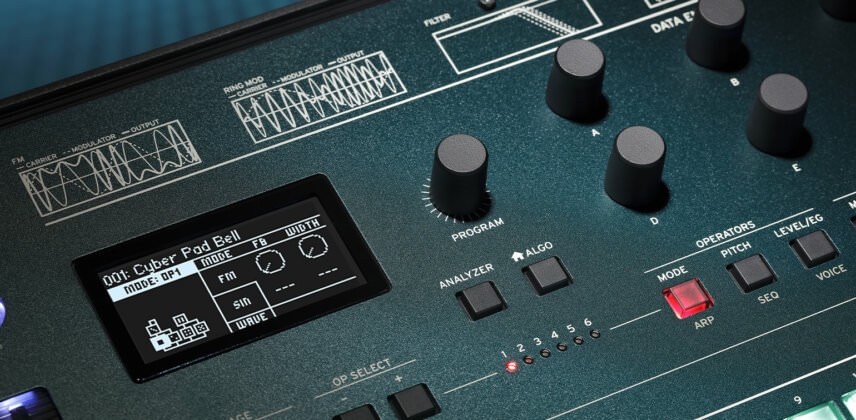
Parameter adjustments for pillars two and three are all handled by controls on the right side of the panel. Menus are accessed via the OLED screen with six rotaries controlling the data entry. A line of six buttons underneath allow direct access to operator modes, pitch adjustments and equalisation and to the modulation, filters and effects, respectively.
The Performance Section
Underlining everything, quite literally, is the performance section. The controls for the 16-step polyphonic sequencer span the width of the machine, sitting atop a sadly plastic and bouncy feeling 32-note keyboard. The sequencer can record up to six notes per step, with velocity, gate time and playback timing editable for each note whilst a motion sequencer offers recording of real-time changes for up to six parameters. In theory, the sequencer is very powerful but in practice, we found it uninspiring so instead relied on external hardware for composing, although being able to play each recording note using the step buttons and then go into them and adjust their six components individually is a great feature that many people will find very useful.
The Final Verdict
At £569, the opsix is certainly not an outrageously priced synth, especially when you consider it has 32-note polyphony. Its nearest competitor is the Elektron Digitone Keys, which at £749 and only eight-voice polyphony seems like less bang for the buck.
In evaluation, the opsix might be FM but it is definitely not a DX7, nor is it just a big Volca FM. Korg have done right and tipped their hat to the building re-emergence of interest in FM but rather than just repackage and rebadge Yamaha’s 1980s efforts they have clearly taken up the spirit of invention that birthed the original DX range and successfully created something fresh. Although the end result does not quite have the unique enigmatic character that, even 40 years on, still makes the DX7 feel like it just arrived from outer space, the opsix more than lives up to its Altered FM claim and goes a long way to keep John Chowning’s original ideas out of the realm of the also-rans or relegated to the limited enthusiasms of the retro-kit crowd.
